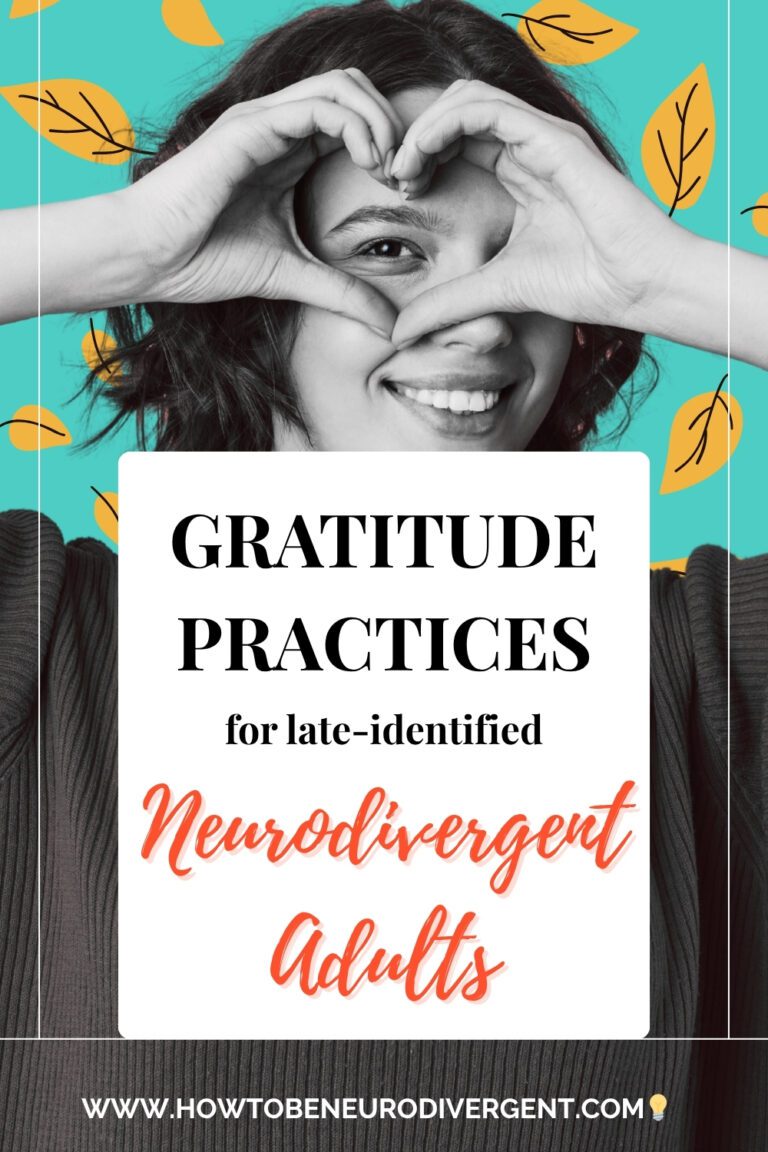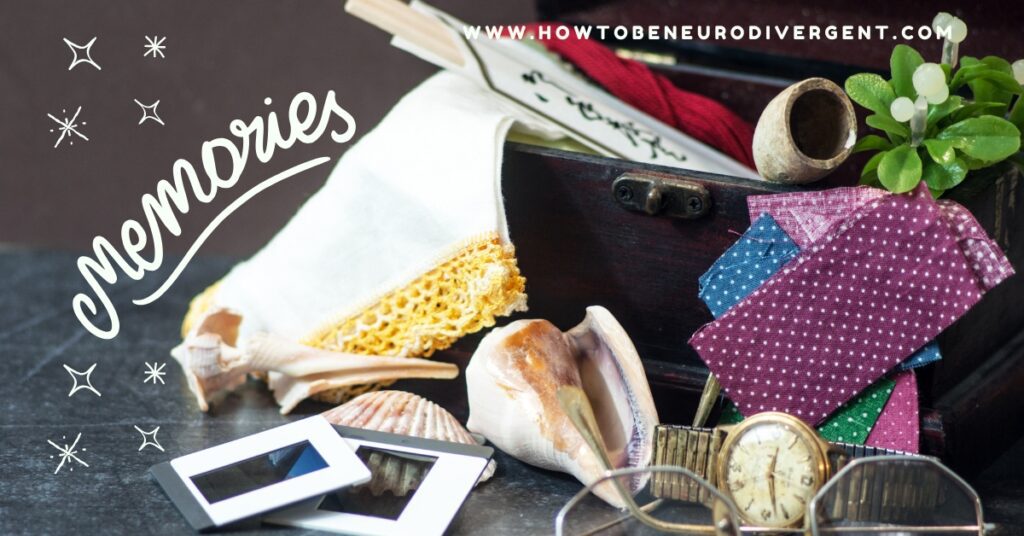Table of Contents
ToggleGratitude
Ever considered adapting gratitude practices for ADHD & autistic brains?
Everywhere you look, gratitude is framed as a daily discipline. It’s something you’re supposed to practice with structure and consistency. Write three things in a journal. Every day. Stick with it. Stay positive.
And if you don’t?
It’s easy to feel like you’re doing it wrong… or that gratitude just isn’t for you.
But here’s the truth:
Traditional gratitude practices weren’t built with neurodivergent brains in mind.
If you’re a late-identified autistic or ADHD adult, chances are your relationship with habits, reflection, or emotional expression looks different from the standard “write-it-down-at-bedtime” model.
Maybe it’s time to try a different approach.

Why Traditional Gratitude Practices Can Be Hard
Many gratitude tools rely on skills that are often inconsistent or a struggle for neurodivergent people:
- Executive function → remembering, planning, repeating daily tasks
- Working memory → recalling the moment you want to record
- Motivation & dopamine → novelty wears off quickly
- Masking history → difficulty accessing genuine internal experiences
- Burnout → survival mode leaves little room for reflection
We know gratitude can be good for us. We want to feel it. But when we’re already managing burnout, executive dysfunction, sensory overload, or years of internalized “shoulds,” even a practice meant to be calming can start to feel like another demand.
Typical gratitude practices (like journaling three things you’re thankful for every day) can be helpful for some. But for others, they can quickly feel forced, repetitive, or disconnected.
When your brain is wired for novelty, you might lose interest fast.
When your executive function is taxed, starting another “daily routine” might feel impossible.
So sometimes a well-meaning practice like journaling becomes another “should.”
It’s not that gratitude doesn’t work, but how we practice it matters. Gratitude can feel like relief instead of just another obligation.
What Gratitude Actually Is (A Nervous System Reframe)
Gratitude is about tiny moments of noticing what feels good in your life.
- Comfort
- Calm
- Pleasure
- Connection
- Safety
These moments don’t cancel out struggle, but they coexist with it.
And those tiny moments of recognition? They help shift the nervous system out of hypervigilance, even if only for an instant.
That’s progress. That’s regulation. Gratitude can greatly improve emotional well-being.
It’s easy to get caught up in thought spirals that exclude these glimmers of gratitude. But there are methods to help keep thankfulness a regular part of your being.

Neurodivergent-Friendly Ways to Practice Gratitude
Let’s ditch the journaling guilt and try something aligned with the reality of our day-to-day lives You don’t need to prove your gratitude to anyone. It can be as basic as intentionally noticing what helps you feel connected to what truly matters to you and what builds you up. Let it be something you choose to experience, not something you force yourself into.
Here are some adapted gratitude practices that actually work for neurodivergent adults:
1. Sensory Gratitude
Gratitude doesn’t have to come with a list. It can be as simple as pausing to notice something that feels good.
Notice things that feel good in your body.
- A Warm blanket
- Soft fabric
- The rhythm of rain
- A warm mug in your hands
- The way your favorite son hits just right
- A Favorite flavor
- A cozy smell
You don’t have to write it down. You don’t even have to name it. Just set an intention to notice. Feel the heat of a cozy fireplace, watch the light flicker, enjoy the scent of warm spices in your favorite holiday treats. It’s worth it, and it makes a difference.
2. Spontaneous Gratitude Logs
Instead of daily planning, capture moments when they happen:
- Voice memo
- Quick photo
- Sticky note
- A text to yourself
- An album of “good moments”
You can even look back over past messages, notes, and photographs with an eye of appreciation. If being present in the moment is difficult for you, this may be a good place to start. You may be surprised at the reassurance you find.
3. Special Interest Gratitude
Tie gratitude into something you already enjoy:
- Collect things that make you smile
- Track moments related to your passion
- Make a playlist that feels good
Allow yourself time to indulge in activities that you know will bring you joy. The ability to become completely engrossed in the things that interest us can bring a lightness to our hearts that is the perfect basis for sincere gratitude.

4. Object-Based Reminders
Create a gratitude shelf or a little space where items live that remind you of joy, comfort, or connection:
- A ticket stub
- A seashell
- A plushie
- A doodle from someone you love
It might be nice to have tangible reminders of an often theoretical concept. A shelf or a box full of keepsakes that bring to mind positive memories can be just as effective as more structured or formal methods.
Body-Centered Gratitude
Ask:
“What feels slightly better right now?”
Then savor it:
- Adjusting lighting
- Taking a deep breath
- Stretching
- Using a fidget
Small shifts count. You can even use a body-scanning meditation to help you focus on physical sensations and notice the differences in tension and relaxation.
Both/And Gratitude
You can be grateful and tired. Thankful and grieving. Appreciative and still wanting change.
Gratitude doesn’t cancel out pain. It can sit beside it. Practice holding dual truths. Allowing both to exist creates space for compassion instead of guilt. No need to lean towards toxic positivity. Just keep space for the whole experience.
It Doesn't Have to Look Like Anyone Else's Practice
Your gratitude can be messy, inconsistent, spontaneous, and sensory-rich.
You don’t have to power through discomfort to get there.
If your version of gratitude looks like:
- “This tea is good.”
- “I love this episode.”
- “My bed feels safe.”
These are valid observations.
Gratitude doesn’t have to be written to be real.
And it doesn’t have to be daily to make a difference.

Closing Thoughts
Your brain doesn’t need to change for gratitude to be possible.
And adapting gratitude practices for ADHD & autistic brains doesn’t have to be a mindset trick. It can be allowing yourself to feel thankful for the small things, shifting your brain from survival mode to moments of peaceful regulation.
Try noticing one tiny moment today.
That’s enough
If you enjoyed this article, you might like this one 👉Surviving the Holidays as a ND Adult: Sensory, Social, & Emotional Strategies.
Thanks for listening, friends.

Disclaimer:
This post reflects my personal experiences and perspectives as a late-identified neurodivergent adult. While I aim to share helpful insights, I don’t speak on behalf of the entire ADHD or autistic community. Neurodivergence is diverse and individual—please interpret this content through the lens of your own needs and experiences. This article is not a substitute for professional or medical advice.

